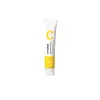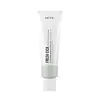What's inside
What's inside
 Key Ingredients
Key Ingredients

 Benefits
Benefits

 Concerns
Concerns

 Ingredients Side-by-side
Ingredients Side-by-side

Water
Skin ConditioningGlycerin
HumectantButylene Glycol
HumectantDimethicone
EmollientCyclopentasiloxane
EmollientCetearyl Alcohol
Emollient1,2-Hexanediol
Skin ConditioningNiacinamide
SmoothingCaprylic/Capric Triglyceride
MaskingBehenyl Alcohol
EmollientPanthenol
Skin ConditioningDimethicone/Vinyl Dimethicone Crosspolymer
Skin ConditioningPEG-40 Stearate
EmulsifyingGlyceryl Stearate
EmollientMannitol
HumectantSqualane
EmollientCeramide NP
Skin ConditioningHydrogenated Lecithin
EmulsifyingStearyl Alcohol
EmollientArachidyl Alcohol
EmollientArginine
MaskingMicrocrystalline Cellulose
AbsorbentAcrylates/C10-30 Alkyl Acrylate Crosspolymer
Emulsion StabilisingCitrus Aurantium Dulcis Peel Oil
MaskingZea Mays Starch
AbsorbentEthylhexylglycerin
Skin ConditioningDipotassium Glycyrrhizate
HumectantSynthetic Fluorphlogopite
Adenosine
Skin ConditioningDisodium EDTA
Ascorbic Acid
AntioxidantAscorbyl Palmitate
AntioxidantCI 77492
Cosmetic ColorantEthylcellulose
Hippophae Rhamnoides Water
MaskingSalicylic Acid
MaskingSodium Hyaluronate
HumectantGluconolactone
Skin ConditioningCitric Acid
BufferingCamellia Sinensis Leaf Extract
AntimicrobialLavandula Angustifolia Flower Extract
CleansingFreesia Refracta Extract
Skin ConditioningMentha Piperita Leaf Extract
Skin ConditioningChamomilla Recutita Flower Extract
MaskingMonarda Didyma Leaf Extract
Skin ConditioningRosmarinus Officinalis Leaf Extract
AntimicrobialCoffea Arabica Seed Extract
MaskingPyrus Malus Fruit Extract
Skin ConditioningCentella Asiatica Extract
CleansingLimonene
PerfumingWater, Glycerin, Butylene Glycol, Dimethicone, Cyclopentasiloxane, Cetearyl Alcohol, 1,2-Hexanediol, Niacinamide, Caprylic/Capric Triglyceride, Behenyl Alcohol, Panthenol, Dimethicone/Vinyl Dimethicone Crosspolymer, PEG-40 Stearate, Glyceryl Stearate, Mannitol, Squalane, Ceramide NP, Hydrogenated Lecithin, Stearyl Alcohol, Arachidyl Alcohol, Arginine, Microcrystalline Cellulose, Acrylates/C10-30 Alkyl Acrylate Crosspolymer, Citrus Aurantium Dulcis Peel Oil, Zea Mays Starch, Ethylhexylglycerin, Dipotassium Glycyrrhizate, Synthetic Fluorphlogopite, Adenosine, Disodium EDTA, Ascorbic Acid, Ascorbyl Palmitate, CI 77492, Ethylcellulose, Hippophae Rhamnoides Water, Salicylic Acid, Sodium Hyaluronate, Gluconolactone, Citric Acid, Camellia Sinensis Leaf Extract, Lavandula Angustifolia Flower Extract, Freesia Refracta Extract, Mentha Piperita Leaf Extract, Chamomilla Recutita Flower Extract, Monarda Didyma Leaf Extract, Rosmarinus Officinalis Leaf Extract, Coffea Arabica Seed Extract, Pyrus Malus Fruit Extract, Centella Asiatica Extract, Limonene
Water
Skin ConditioningDimethicone
EmollientButylene Glycol
HumectantChamaecyparis Obtusa Water
MaskingHydroxyethyl Acrylate/Sodium Acryloyldimethyl Taurate Copolymer
Emulsion StabilisingAsiaticoside
AntioxidantAsiatic Acid
Skin ConditioningMadecassic Acid
Skin ConditioningCentella Asiatica Extract
CleansingMadecassoside
AntioxidantCeramide NP
Skin ConditioningPanthenol
Skin ConditioningAllantoin
Skin ConditioningGlycerin
HumectantHydrogenated Lecithin
EmulsifyingTrehalose
HumectantSorbitol
HumectantAlcohol
AntimicrobialCarbomer
Emulsion StabilisingTromethamine
BufferingSodium Hyaluronate
HumectantPolysorbate 20
EmulsifyingCitrus Aurantium Bergamia Fruit Oil
MaskingCitrus Aurantium Dulcis Peel Oil
MaskingRosmarinus Officinalis Leaf Oil
MaskingLavandula Angustifolia Oil
MaskingPelargonium Graveolens Flower Oil
MaskingAmyris Balsamifera Bark Oil
MaskingCitrus Paradisi Peel Oil
MaskingMelaleuca Alternifolia Leaf Oil
AntioxidantEucalyptus Globulus Leaf Oil
PerfumingJuniperus Mexicana Oil
MaskingBoswellia Carterii Oil
MaskingAniba Rosaeodora Wood Oil
AstringentDisodium EDTA
Caprylyl Glycol
EmollientEthylhexylglycerin
Skin ConditioningWater, Dimethicone, Butylene Glycol, Chamaecyparis Obtusa Water, Hydroxyethyl Acrylate/Sodium Acryloyldimethyl Taurate Copolymer, Asiaticoside, Asiatic Acid, Madecassic Acid, Centella Asiatica Extract, Madecassoside, Ceramide NP, Panthenol, Allantoin, Glycerin, Hydrogenated Lecithin, Trehalose, Sorbitol, Alcohol, Carbomer, Tromethamine, Sodium Hyaluronate, Polysorbate 20, Citrus Aurantium Bergamia Fruit Oil, Citrus Aurantium Dulcis Peel Oil, Rosmarinus Officinalis Leaf Oil, Lavandula Angustifolia Oil, Pelargonium Graveolens Flower Oil, Amyris Balsamifera Bark Oil, Citrus Paradisi Peel Oil, Melaleuca Alternifolia Leaf Oil, Eucalyptus Globulus Leaf Oil, Juniperus Mexicana Oil, Boswellia Carterii Oil, Aniba Rosaeodora Wood Oil, Disodium EDTA, Caprylyl Glycol, Ethylhexylglycerin
Ingredients Explained
These ingredients are found in both products.
Ingredients higher up in an ingredient list are typically present in a larger amount.
Butylene Glycol (or BG) is used within cosmetic products for a few different reasons:
Overall, Butylene Glycol is a safe and well-rounded ingredient that works well with other ingredients.
Though this ingredient works well with most skin types, some people with sensitive skin may experience a reaction such as allergic rashes, closed comedones, or itchiness.
Learn more about Butylene GlycolCentella Asiatica Extract (Centella) is derived from an herb native to Southeast Asia. It is famous for its anti-inflammatory and soothing properties.
Centella is rich in antioxidants and amino acids, such as Madecassic Acid and Asiaticoside.
Studies show the compounds in centella help with:
The combination of all these properties makes centella effective at soothing, hydrating, and protecting the skin.
Other great components of centella include Vitamin A, vitamin C, several B vitamins, and Asiatic Acid.
Fun fact: Centella has been used as a medicine and in food for many centuries. As a medicine, it is used to treat burns, scratches, and wounds.
Learn more about Centella Asiatica ExtractCeramide NP is a type of ceramide and formally known as ceramide 3.
Ceramides are intercellular lipids naturally found in our skin that bonds dead skin cells together to create a barrier. They are known for their ability to hold water and thus are a great ingredient for dry skin.
Ceramides are an important building block for our skin barrier. A stronger barrier helps the skin look more firm and hydrated. By bolstering the skin ceramides act as a barrier against irritating ingredients. This can help with inflammation as well.
If you would like to eat ceramides, sweet potatoes contain a small amount.
Read more about other common types of ceramides here:
Ceramide AP
Ceramide EOP
Citrus Aurantium Dulcis Peel Oil is oil from the peel of an orange fruit.
Limonene and linalool make up the majority of oils from citrus peels. Limonene has a "citrus" fragrance. Citrus peels also contain flavonoids, which have anti-inflammatory properties.
Citrus peel is also a rich source of flavonoids. Flavonoids are natural antioxidants and help protect your skin against damage. Flavonoids are a group of compounds naturally found in vegetables and fruits.
The term 'fragrance' is not regulated in many countries. In many cases, it is up to the brand to define this term. For instance, many brands choose to label themselves as "fragrance-free" because they are not using synthetic fragrances. However, their products may still contain ingredients such as essential oils that are considered a fragrance.
Learn more about Citrus Aurantium Dulcis Peel OilDimethicone is a type of synthetic silicone created from natural materials such as quartz.
What it does:
Dimethicone comes in different viscosities:
Depending on the viscosity, dimethicone has different properties.
Ingredients lists don't always show which type is used, so we recommend reaching out to the brand if you have questions about the viscosity.
This ingredient is unlikely to cause irritation because it does not get absorbed into skin. However, people with silicone allergies should be careful about using this ingredient.
Note: Dimethicone may contribute to pilling. This is because it is not oil or water soluble, so pilling may occur when layered with products. When mixed with heavy oils in a formula, the outcome is also quite greasy.
Learn more about DimethiconeDisodium EDTA plays a role in making products more stable by aiding other preservatives.
It is a chelating agent, meaning it neutralizes metal ions that may be found in a product.
Disodium EDTA is a salt of edetic acid and is found to be safe in cosmetic ingredients.
Learn more about Disodium EDTAEthylhexylglycerin (we can't pronounce this either) is commonly used as a preservative and skin softener. It is derived from glyceryl.
You might see Ethylhexylglycerin often paired with other preservatives such as phenoxyethanol. Ethylhexylglycerin has been found to increase the effectiveness of these other preservatives.
Glycerin is already naturally found in your skin. It helps moisturize and protect your skin.
A study from 2016 found glycerin to be more effective as a humectant than AHAs and hyaluronic acid.
As a humectant, it helps the skin stay hydrated by pulling moisture to your skin. The low molecular weight of glycerin allows it to pull moisture into the deeper layers of your skin.
Hydrated skin improves your skin barrier; Your skin barrier helps protect against irritants and bacteria.
Glycerin has also been found to have antimicrobial and antiviral properties. Due to these properties, glycerin is often used in wound and burn treatments.
In cosmetics, glycerin is usually derived from plants such as soybean or palm. However, it can also be sourced from animals, such as tallow or animal fat.
This ingredient is organic, colorless, odorless, and non-toxic.
Glycerin is the name for this ingredient in American English. British English uses Glycerol/Glycerine.
Learn more about GlycerinHydrogenated Lecithin is created from the hydrogenation of lecithin (a group of phospholipids). Hydrogenation is a chemical reaction between hydrogen and another element.
This ingredient is an emollient and emulsifier. As an emollient, it helps soften skin by trapping moisture within. As an emulsifier, it prevents oil and water ingredients from separating.
Panthenol is a common ingredient that helps hydrate and soothe the skin. It is found naturally in our skin and hair.
There are two forms of panthenol: D and L.
D-panthenol is also known as dexpanthenol. Most cosmetics use dexpanthenol or a mixture of D and L-panthenol.
Panthenol is famous due to its ability to go deeper into the skin's layers. Using this ingredient has numerous pros (and no cons):
Like hyaluronic acid, panthenol is a humectant. Humectants are able to bind and hold large amounts of water to keep skin hydrated.
This ingredient works well for wound healing. It works by increasing tissue in the wound and helps close open wounds.
Once oxidized, panthenol converts to pantothenic acid. Panthothenic acid is found in all living cells.
This ingredient is also referred to as pro-vitamin B5.
Learn more about PanthenolSodium Hyaluronate is hyaluronic acid's salt form. It is commonly derived from the sodium salt of hyaluronic acid.
Like hyaluronic acid, it is great at holding water and acts as a humectant. This makes it a great skin hydrating ingredient.
Sodium Hyaluronate is naturally occurring in our bodies and is mostly found in eye fluid and joints.
These are some other common types of Hyaluronic Acid:
Learn more about Sodium HyaluronateWater. It's the most common cosmetic ingredient of all. You'll usually see it at the top of ingredient lists, meaning that it makes up the largest part of the product.
So why is it so popular? Water most often acts as a solvent - this means that it helps dissolve other ingredients into the formulation.
You'll also recognize water as that liquid we all need to stay alive. If you see this, drink a glass of water. Stay hydrated!
Learn more about Water